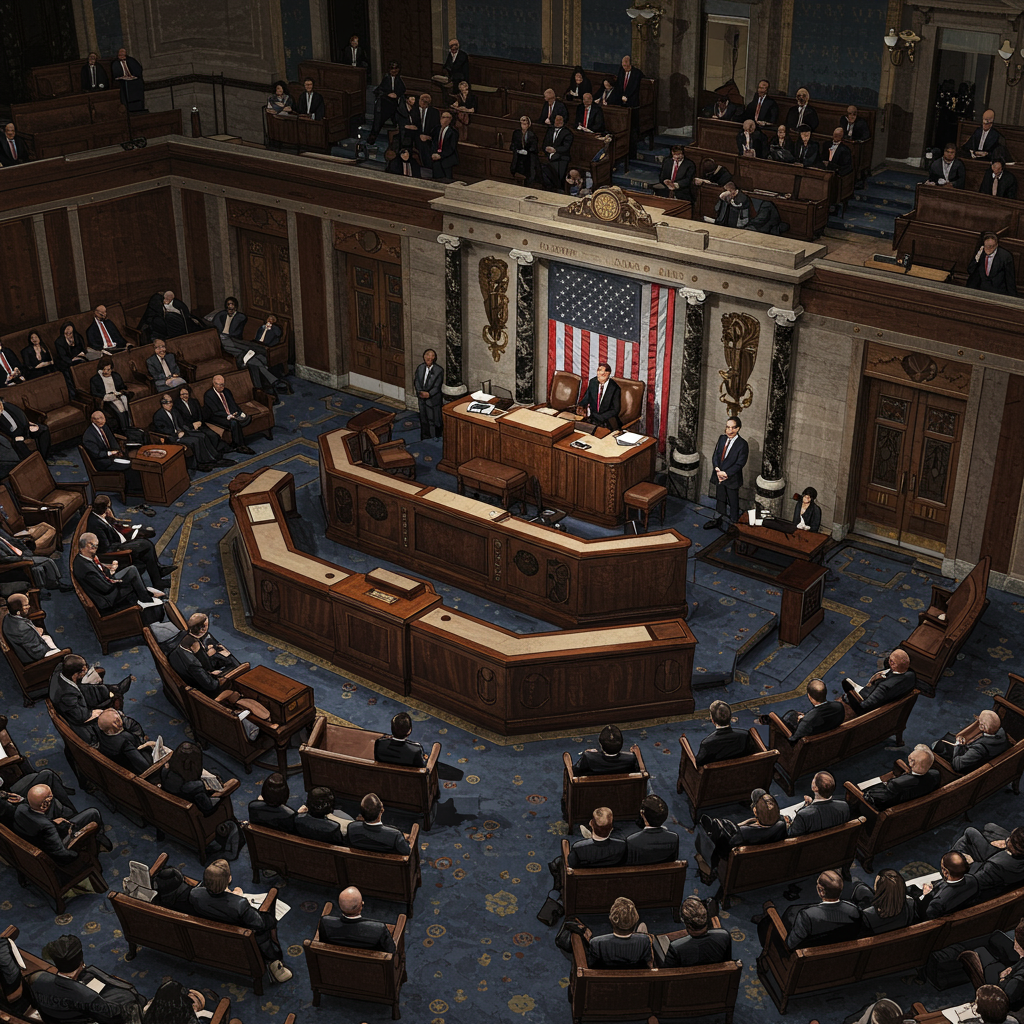Washington, D.C. is abuzz as the U.S. house of Representatives grapples with a decisive vote today on President Donald Trump’s significant tax and spending package. Often dubbed the “One Big Beautiful Bill,” this legislation is on a fast track, arriving in the House just a day after narrowly clearing the senate. Republican leaders are pushing hard, working against the clock to pass the complex, nearly 900-page measure and send it to the President’s desk before his target July 4th signing deadline. This legislative sprint represents a high-stakes political maneuver, leveraging momentum from the Senate passage and applying significant pressure on House Republicans to support their party leader’s core domestic policy goal.
Decoding the ‘One Big Beautiful Bill’
At its core, this extensive bill consolidates a range of Republican policy priorities, mixing substantial tax reductions with significant cutbacks in federal expenditures. Proponents argue the package is essential to prevent the 2017 Trump tax cuts from expiring as scheduled, asserting it will provide a crucial boost to the economy. They specifically highlight benefits for workers earning wages, overtime pay, and even recipients of Social Security, pointing to features like expanded tax breaks and a higher child tax credit designed to support American families. The bill also allocates new funding streams, notably targeting national defense and bolstering deportation efforts, reflecting key administration focuses.
However, nonpartisan analysis presents a starkly different view of the bill’s potential long-term effects. The Congressional Budget Office (CBO) recently estimated that the version passed by the Senate would add roughly $3.3 trillion to the national debt over the coming decade (2025-2034). This figure represents a near $1 trillion increase compared to the CBO’s projection for the initial version passed by the House. More alarming, the CBO also estimated the legislation could lead to approximately 11.8 million Americans losing their health insurance coverage by 2034, primarily due to proposed changes to healthcare programs. These projections intensify opposition and underscore the deep political chasm surrounding the bill’s anticipated impact on the nation’s fiscal health and its citizens.
Navigating the Political High Wire Act in the House
The rush towards a House vote is thick with political tension and uncertainty. With a narrow Republican majority of 220-212, GOP leadership can tolerate very few defections from their ranks to secure the bill’s passage. Compounding the challenge, severe weather has disrupted flights into Washington, forcing some lawmakers to undertake lengthy overnight car journeys to ensure they are present for critical votes. Speaker Mike Johnson has publicly acknowledged attendance issues, emphasizing the need to confirm a “full House” for voting.
Republican leaders are engaged in intensive closed-door meetings and last-minute lobbying efforts targeting hesitant members. President Trump himself is actively involved, with White House officials confirming he is meeting with various House Republican factions. These include moderate members and those from the conservative Freedom Caucus, attempting to address concerns and consolidate support. Trump has also utilized social media platforms, urging Republicans to stand firm against Democratic opposition.
Despite this concerted pressure, internal dissent persists within the Republican conference. Some conservative members, particularly from the Freedom Caucus, remain deeply concerned about the bill’s impact on future deficits. They argue that changes made during the Senate process fail to adequately balance the proposed tax cuts with equivalent spending reductions promised earlier. Figures like Rep. Eric Burlison have publicly deemed the Senate’s alterations “unacceptable.” Reps. Ralph Norman and Tim Burchett have voiced worries about insufficient spending cuts and expressed skepticism towards the common legislative practice of promising to address issues later, raising doubts about their support for essential procedural votes needed to move the bill forward.
Nevertheless, the President’s influence appears to be shifting some votes. Rep. Warren Davidson, who voted against an earlier iteration of the bill in May, has announced his intention to vote “yes” this time. Davidson highlighted specific additions as “major wins,” including new work requirements for Medicaid recipients and enhanced work requirements for the food stamp program (SNAP), alongside provisions aimed at border security.
Unified Democratic Opposition Mounts
House Democrats are presenting a united front in their strong opposition to the bill, having quickly rebranded it the “one big ugly bill.” Led by Minority Leader Hakeem Jeffries, Democrats contend the legislation is essentially an act of “robbery,” arguing it effectively transfers wealth from vulnerable populations to the wealthy elite through deep cuts to essential safety net programs like Medicaid and SNAP. During floor debates, Democrats have employed parliamentary tactics, repeatedly requesting to amend the resolution to protect these programs. While Republican procedure blocks these attempts, the strategy allows Democrats to loudly voice their concerns and demonstrate party unity for public view and the official Congressional Record.
Democratic leaders are also specifically targeting Republicans from competitive districts, urging them to vote against the bill. They suggest these members will face a political cost if they support what Democrats portray as an assault on working families and seniors. Leaders like Rep. Jim McGovern have fiercely criticized the bill as “cowardly” and a “betrayal” of American values. Rep. Alexandria Ocasio-Cortez starkly contrasted potential tax cuts on tipped income with the significant risk millions face of losing essential healthcare and food assistance under the bill’s provisions.
Key Provisions Fueling Intense Debate
Two of the most heavily debated components of the “One Big Beautiful Bill” involve significant changes to social programs and clean energy policy:
Medicaid and SNAP Work Requirements: The bill introduces new or enhanced work requirements for individuals receiving benefits from Medicaid and the Supplemental Nutrition Assistance Program. Supporters, like Rep. Davidson, view these as necessary reforms to encourage self-sufficiency. However, opponents argue these changes will inevitably lead to millions of Americans losing coverage or assistance, including vulnerable populations such as children, seniors, and individuals with disabilities. The bill currently plans for Medicaid work requirements to begin taking effect in 2027. The Senate version also included a new $50 billion fund over five years, starting in 2026, aimed at mitigating the negative impact on rural hospitals potentially affected by changes related to state provider taxes used for federal matching funds. While Senator Lisa Murkowski secured a specific reprieve for Alaska from new SNAP work requirements, illustrating the complexity and negotiation involved, Senator Rand Paul criticized such concessions as potentially “purchasing” votes. President Trump himself, during a recent meeting with House Republicans, reportedly advised against cutting Medicaid program benefits directly, instead advocating for strengthening the program by eliminating “waste, fraud, and abuse,” stating, “We want to strengthen Medicaid. We want to strengthen Medicare.” This adds a layer of complexity to understanding the administration’s specific intent versus the bill’s projected impacts.
Clean Energy Incentives Rollback: The bill proposes a sharp reduction in clean energy tax credits. Most notably, it eliminates the 30% tax credit for rooftop residential solar installations by the end of 2025. This credit had previously been extended into the next decade under the Inflation Reduction Act from the prior administration. President Trump has publicly dismissed such credits as part of a “green new scam.” Industry analysts and businesses across the country warn that prematurely ending this incentive will likely reverse recent growth in the U.S. solar sector, potentially leading to significant job losses. Karl Stupka, president of NC Solar Now, estimated that his company might need to lay off half of its 100 employees if the bill becomes law, as companies rush to complete projects before the year-end deadline. The bill also reportedly removes the $7,500 credit for buying electric cars and rolls back credits for wind energy, impacting an estimated $522 billion in planned investments across the clean energy sector.
Broader Context: Beyond the Bill’s Immediate Scope
While the tax and spending bill dominates headlines and legislative efforts, the day’s events unfold within a larger context of other significant administration actions and policy challenges:
Border Policy Developments: A recent federal judge’s ruling has blocked President Trump’s executive order that aimed to suspend asylum access at the southern border. The judge ruled the order exceeded presidential authority and violated existing immigration law, granting the administration two weeks to appeal. This legal challenge occurs as border crossing arrests have reportedly fallen to decades-long lows in recent months, following increased enforcement efforts by Mexico and previous U.S. policy changes. These efforts were amplified by the Trump administration’s deployment of troops under a national emergency declaration. The bill’s allocation of specific funds for deportations highlights the administration’s continued focus on enforcement. The bill also reportedly introduces a new $1,000 fee for asylum seekers, a provision criticized by advocates as creating an undue burden on individuals fleeing persecution.
Ukraine Aid Review: The Pentagon recently announced a pause in some planned weapons shipments to Ukraine, including crucial Patriot missiles and precision-guided artillery. Spokesperson Sean Parnell indicated this pause is part of a wider review aimed at ensuring military assistance aligns optimally with U.S. defense priorities, citing concerns about the adequacy of domestic stockpile levels.
Tariff Impact Analysis: A recent analysis from the JPMorganChase Institute estimated that tariffs imposed by the Trump administration could cost mid-sized U.S. businesses (those with $10 million to $1 billion in annual revenue) approximately $82.3 billion. This finding directly challenges the administration’s assertion that foreign manufacturers absorb the cost of tariffs, suggesting instead that American companies relying on imported goods, particularly in the retail and wholesale sectors, are bearing the significant financial burden. This analysis provides important context for the administration’s broader trade policy focus, including recently announced trade agreements.
Debt Ceiling Concerns: While the bill was passed in the Senate using the reconciliation process to bypass filibuster, the differing versions between the House (approving a $4 trillion debt ceiling hike) and the Senate (opting for a $5 trillion increase) present a point of difference that must be reconciled. Lifting the debt limit is necessary for the government to pay for spending already authorized by Congress. Treasury Secretary Scott Bessent has warned that without action, the U.S. risks a potentially catastrophic federal debt default as early as August, adding another layer of urgency to the legislative calendar.
The debate on the House floor continues to showcase the profound partisan divide over the bill’s contents and projected consequences. While Republican leaders project confidence, the extremely narrow majority, persistent internal dissent, and logistical hurdles mean that passage, while widely expected, is far from guaranteed without a coordinated and potentially challenging effort to secure every needed vote. The legislative path requires the House to pass the Senate version precisely as written, or for the two chambers to reconcile differences in a conference committee, adding further time pressure towards the desired July 4th deadline.
Frequently Asked Questions
What key policies are included in the “One Big Beautiful Bill”?
The bill is a sweeping legislative package combining significant tax breaks and federal spending reductions. Core components include extending the 2017 tax cuts, allocating new funds for national defense and deportation efforts, implementing new or enhanced work requirements for programs like Medicaid and SNAP, and eliminating the residential rooftop solar tax credit by the end of 2025. Proponents also highlight expanded general tax breaks and an increased child tax credit as benefits for families. The Senate version also includes a new $50 billion fund for rural hospitals and modifies the deduction cap for state and local taxes (SALT) for certain married couples.
What are the major criticisms and projected impacts of the bill?
Critics point to significant concerns about the bill’s cost and effects on vulnerable populations. The nonpartisan CBO projects the Senate version could add nearly $3.3 trillion to the national debt over a decade and potentially cause 11.8 million Americans to lose health insurance. Democrats argue the bill disproportionately benefits the wealthy by cutting essential programs like Medicaid and SNAP. The planned elimination of the solar tax credit is also controversial, with industry experts warning it could reverse sector growth and lead to job losses. Additionally, proposed changes to Medicaid and SNAP work requirements and a new fee for asylum seekers draw strong opposition.
What challenges does the bill face in the House and what are the next steps?
After narrow Senate passage, the bill must pass the House with its current, narrow Republican majority of 220-212, meaning very few ‘no’ votes are possible. Internal Republican dissent, particularly from conservatives concerned about the deficit impact of the Senate version, poses a significant challenge. Logistical issues like weather-hampered travel add to the difficulty of ensuring full attendance for votes. To become law, the House must pass the exact same version as the Senate. Republican leadership aims for a vote today, July 2nd, pushing towards a July 4th deadline, but securing the votes requires intense lobbying efforts and overcoming internal divisions. Failure to pass today could delay action and necessitate further negotiation or a conference committee if the House alters the bill.




